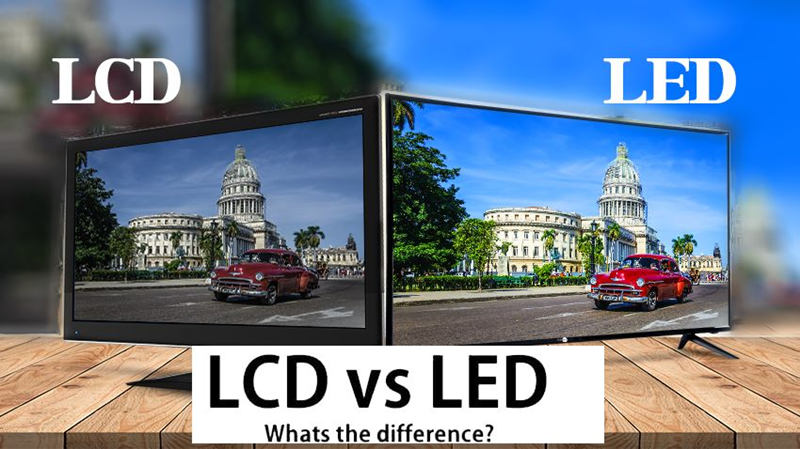
What Is The Difference Between LCD and LED?
Share
You must have seen most kinds of screens in your life, and the display technology is constantly developing. Liquid Crystal Display (LCD) and Light Emitting Diode (LED), as two important digital display technologies, have been widely used in various fields. Although they all belong to digital display technology, there are certain differences in their working principles and characteristics. This article will introduce the differences between LCD and LED in terms of working principle, brightness and energy consumption, color and color gamut, price and application scenarios.

1.Different working principles
LCD is a digital display technology that uses the anisotropy of liquid crystal molecules and electric field control to adjust the light transmittance, thereby realizing image display. It mainly consists of two parallel glass plates with liquid crystal molecules sandwiched between them. When electrified, the liquid crystal molecules will be deformed, which will affect the light transmittance and make the object present an image. The working principle of LCD is similar to a light valve, so it is also called light valve display technology.

Unlike LCD, LED is a digital display technology that uses electric current excitation of semiconductor materials to produce bright light. An LED is a light-emitting diode that excites photons in a semiconductor material through an electric current, thereby producing light. LED consists of light-emitting diodes and external circuits. When electricity is applied, the carriers in the semiconductor material are excited, which emit photons and produce light. The working principle of LED is similar to that of a chip, so it is also called LED chip technology.

2.The difference in brightness and energy consumption
LED has higher brightness and lower energy consumption, mainly because it uses light-emitting diodes to generate light, avoiding the process of using phosphor powder to generate bright light in traditional display technology. Compared with phosphors, LEDs emit light more efficiently and can achieve a wider range of colors and a longer lifetime. In addition, LED also has the advantage of adjusting brightness. By adjusting parameters such as current intensity and brightness, the best display effect in different occasions can be achieved.
In contrast, LCD has more uniform brightness and higher resolution, but its power consumption is higher. LCD needs to use a backlight to illuminate the LCD screen, so it consumes a lot of energy. Although LCD can also reduce energy consumption by controlling the backlight source, this often leads to problems such as uneven brightness.

3.The difference between color and color gamut
There are also certain differences between LED and LCD in terms of color and color gamut. LED realizes color gradient and mixing through the combination of RGB three primary colors, so a wider color range and more delicate color transition can be realized. The LCD achieves different color and brightness effects through the change of the backlight source. Although it can also achieve good color performance, its overall color gamut is smaller than that of LEDs.

4.Differences in price and application scenarios
There are also some differences in the price and application scenarios of LED and LCD. Due to their higher brightness, longer lifespan and wider color range, LEDs are widely used in fields such as outdoor displays, lighting and automobiles. LCDs are mainly used in home TVs, computer monitors, and indoor displays in workplaces. In addition, the price of LCD is relatively low, so it is easier to be accepted and popularized.
However, in some specific application scenarios, such as medical and aviation, LCD can also play its advantages. For example, in operating rooms, LCDs are widely used in medical equipment such as MRI and CT because high-precision and high-resolution display equipment is required to assist doctors in surgical operations. In addition, LCD can also achieve a more realistic image display effect through liquid crystal 3D technology.

5.Summary
Although LCD and LED are both digital display technologies, there are obvious differences in their working principle, brightness and energy consumption, color and color gamut, price and application scenarios. When choosing digital display technology, we need to choose according to specific needs and application scenarios to achieve the best effect and cost performance. In the future, with the continuous improvement of digitalization, digital display technologies such as LCD and LED will continue to develop and innovate, bringing people a more convenient and efficient digital experience.

About Oriwhiz
Oriwhiz is a mobile phone LCD/OLED screen and other phone spare parts' manufacturer(factory) which is located in Shenzhen China.We are cell phone display wholesaler(Chinese supplier), offer OEM and ODM service to customers all over the world. Our products have ISO9001,CE,FCC,ROSH certificate. All of our products are manufactured by brand new materials and 100% quality test before shipping. We promise our best quality products will be delivered to our clients on time. We have professional customer service and welcome inquiry any time. Our main products include: iPhone LCD,iPhone Charging Port,iPhone Front Camera,iPhone Back Camera,iPhone ear speaker,iPhone Battery.etc.Not only iPhone related products,we also have mobile phone parts for Samsung,Huawei,Xiaomi Oppo,Vivo etc.
